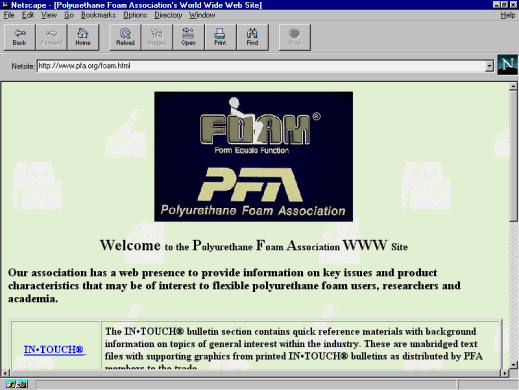

Now that you've got some idea of what HTML can do, wouldn't you like to see the rabbits various Web magicians have pulled from their HTML hats? To that end, the next few sections present some real-world examples of Web pages that show you what you can do with a little HTML know-how. Of course, these examples represent only the smallest subset of the Web world. There are, literally, tens, if not hundreds, of thousands of Web pages out there, and each one is like a digital fingerprint-a unique expression of its creator's individuality.
The simplest, and probably the most common, type of Web page is the personal home page. This is a page that an individual sets up to tell the Web world a little bit about himself. They're the Web equivalent of those "Hi! My Name isà" stickers that people wear at parties and receptions. They range from warm and fuzzy ("Welcome, friend, to my home page!"), to downright vainglorious ("Let me tell you everything there is to know about me"), to frighteningly personal ("Dear diaryà"). The following figure shows the personal home page for yours truly.
| The author's humble HTML home. |  |
Sometimes the hardest thing about putting together a Web page is thinking of something to say. (Although there are plenty of garrulous guys and gals out there for whom this is definitely not a problem!) So what's a body to do about a bad case or Web writer's block? Well, lots of people go with what they know: they talk about their hobbies and interests. Hey, it makes sense. You're more likely to sound enthusiastic and excited about a topic you're keen on, so you're more likely to hold your reader's interest. There are lots of things you can do to fill up your page: introduce the hobby to novices; talk about how you got started; show some samples of your work (depending on the hobby, of course); and include links to related Web pages. The sky's the limit.
As you might imagine, there's no shortage of hobby-related pages on the World Wide Web. You'll find info on everything from amateur radio to millefiori to woodworking. Millefiori!? No, I haven't the faintest idea what it is, either, but the next picture shows a page from someone who does.
| Obscurity is no barrier for Web spinners: a millefiori (?) how to page. | 
|
The Web's marriage of text and graphics meant it was only a matter of time before someone decided to "publish" a Web-based magazine. Now it seems that new electronic magazines (they're also often called e-mags, or e-zines) hit the Web's newsstands every few days. The quality, as you might expect, runs the gamut from professional to pathetic, from slick to sick. But the good ones are very good, with well-written articles, handsome graphics, and some unique approaches to the whole magazine thing. There are, literally, hundreds of e-zines out there, so there's no shortage of reading material. John Labovitz maintains a list of e-zines at the following address:
http://www.meer.net/!johnl/e-zine-list/index.html
The next screen shows the home page for one of the better e-zines: Urban Desires.
| The Urban Desires electronic magazine. |  |
One of the biggest engines driving the growth of the World Wide Web
is the influx of corporations scrambling to get a "presence"
in cyberspace. Companies from mom-
and-pop shops to Fortune 500 behemoths are setting up on the Web in anticipation
of, well, something. Nobody's quite sure why they need a Web site, but
they're happy to put one up, just in case something BIG happens one of
these days. Hey, who can blame them? With all the Internet hype floating
around these days, no self-respecting CEO is going to be caught with his
or her pants down. And, as proof that every corporate entity on the face
of the earth has a Web site, I offer you the following figure: the home
page of the Polyurethane Foam Association!
| At last, the PFA has its own Web site! | 
|
If Big Business is rushing to get on the Web, you better believe Big Brother isn't going to be left behind, either. Yes, governments--local, state, and federal-are putting up Web pages to beat the band. Granted, many of these sites are quite useful. You can use them to contact representatives, read government reports and studies, do research, and more. Some of the pages are even-gasp!-creative. For example, check out the handsome graphics you get when you surf to the home page of the White House (see the next figure).
As I write this, various Web engineers, programmers, and other geeks are busy putting the finishing touches on a new version of HTML: HTML 3.0. There's no need to panic, however. The advent of HTML 3.0 does not mean all the HTML I'll be teaching you in this book isn't worth the paper it's printed on. No, thankfully, HTML 3.0 is an extension of the existing tags, not a replacement of them. I'll be telling you about some of the new features in HTML 3.0 as you work through the next section.
| The White House World Wide Web page. | 
|
This chapter gave you a quick overview of HTML. I showed you what it is and why it isn't as scary as it sounds, and you saw quite a few examples of what HTML can do.
So much for the preliminaries. In the next chapter you'll get started with the nuts and bolts of HTML so you can start building your first Web page.
 |
 |
 |
For comments or technical support for our books and software,
select Talk to
Us.
To order books, call us at 800-716-0044 or 317-228-4366.
⌐ 1996, QUE Corporation, an imprint of Macmillan Publishing USA, a Simon & Schuster Company.